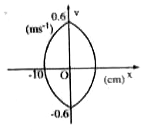The maximum velocity of a particle , executing simple harmonic motion with an amplitude 7mm is 4.4ms−1 . The period of oscillation is Solution in Tamil
Vmax=ωA=2πTA
T=2πAVmax=2×22×7×10−37×4.4=0.01s
Similar Questions
The particle executes simple harmonic motion have periodic time 0.05s and amplitude 4 cm, then what its maximum velocity?
View SolutionA particle executes simple harmonic motion with an amplitude A. The period of oscillation is T. The minimum time taken by the particle to travel half of the amplitude form the equilibrium position is………..
View SolutionA particle is executing simple harmonic motion with an amplitude of 2m . The difference in the magnitudes of its maximum acceleration and maximum velocity is 4. The time period of its oscilation and its velocity when it is 1m away from the mean position are respectively.
View SolutionA particle is executing simple harmonic motion with an amplitude of 2m . The difference in the magnitudes of its maximum acceleration and maximum velocity is 4. The time period of its oscilation and its velocity when it is 1m away from the mean position are respectively.
View SolutionThe maximum velocity of a particle executing simple harmonic motion is v. If the amplitude is doubled and the time period of oscillation decreased to 1/3 of its original value the maximum velocity becomes
View SolutionA particle executing simple harmonic motion with an amplitude A and angularr frequency ω. The ratio of maximum acceleration to the maximum velocity of the particle is
View SolutionFigure shows the graph of velocity versus displacement of a particle executing simple harmonic motion. Find the period of oscillation of the particle

View SolutionA particle is executing simple harmonic motion with an amplitude of 2m. The difference in the magnitudes of its maximum acceleration and maximum velocity is 4. The time period of its oscillation and its velocity when it is 1m away from the mean position are respectively,
View Solution

